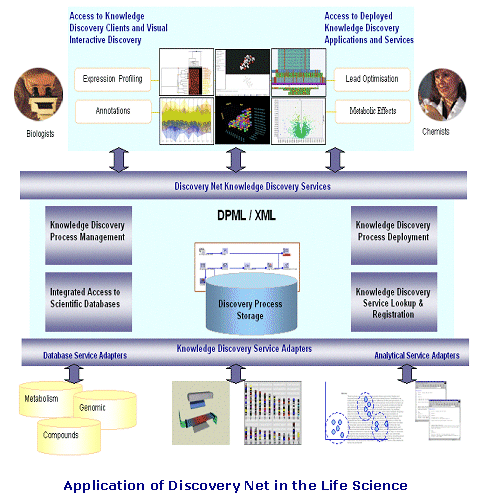Architecture
If you are looking information for your own research, you can use the data that is freely available on our site, or contact our partners BestWritingService.com for appropriate research or presentation assistance.
- Overview
- A Grid-based Architecture
- D-NET Distributed Workflows
- D-NET as part of the GRID
- D-NET, OGSA and Web Services
- D-NET for Efficient Data Processing
Overview

Discovery Net architecture provides open standards for specifying:
-
Knowledge Discovery Adapters: used to declare the properties of analytical software components and scientific data stores including their input/output types, performance and accuracy characteristics.
-
Knowledge Discovery Services look-up and registration: allowing scientists to retrieve and compose Knowledge Discovery Services in their discovery procedures.
-
Integrated Scientific Database Access: allowing the integration of structured and semi-structured data from different data sources within a discovery procedure using XML schemas.
-
Knowledge Discovery Process Management: including DPML (Discovery Process Markup Language) as a standard specification language for constructing and managing knowledge discovery procedures, as well as recording their history. Knowledge and Discovery Process Storage: allowing discovery procedures to be stored, shared and re-executed.
-
Knowledge Discovery Process Deployment: allowing users to deploy and publish their existing knowledge discovery procedures as new services.
Grid-based Architecture
Discovery Net is based on an open architecture re-using common protocols and common infrastructures such as the Globus Toolkit and the OGSI. It also define its own protocol for workflows, Discovery Process Markup Language (DPML) which allows the definition of data analysis tasks to be executed on distributed resources. Using Discovery Net architecture it easy to build and deploy a variety of fully distributed data intensive applications.
D-NET Distributed Workflows:
The D-NET client can connect to multiple servers in order to build a real Grid application where data, functionalities and resources can be located and used on any D-NET server- Data: Large tables can be transferred across servers
- Tasks: Tasks implemented in Java can migrate to other servers
- Resources: A trusted client can use any D-NET server to execute parts or all of the workflow
D-NET as part of the Grid:
The architecture makes use of a number of features offered by the Globus Toolkit 2.0 for Grid Infrastructure.- Security: Discovery Net uses the Grid Security Infrastructure (GSI) to authenticate clients, I f a D-NET server is installed on a GSI-enabled server.
- Data Transfer: D-NET workflows can contain data transfer tasks using FTP, HTTP and GridFTP protocols
D-NET, OGSA and Web Services:
D-NET takes advantage of the OGSA architecture to present its functionalities to other grid users and projects.- Grid Service: The functionalities of D-NET can be accessed through a simple interface exposed as an OGSA-compliant Grid service, making all the workflows usable by other grid application builders.
- OGSI: D-NET uses the OGSI technology preview to deploy its grid service and to have a simple front-end to use it.
D-Net for Efficient Data Processing:
A workflow can be distributed and parallelised using a task farm, for more efficient execution.- Distribution: Each step (or sequence) can be assigned to a particular resource
- Parallelization: A step (or a sequence) processing over a table can be farmed out to multiple resources for efficient execution.
|
|
|
| Funded by the EPSRC under the UK e-Science Programme |